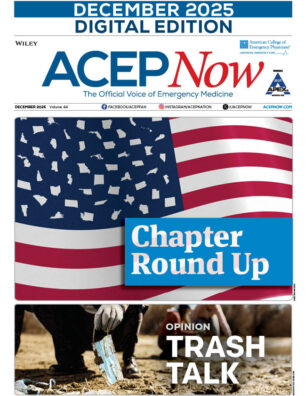
Case: A 73-year-old woman presents to the emergency department (ED) via EMS complaining of palpitations and shortness of breath since she woke up. The monitor shows irregular rhythm with a rate of 154 beats per minute (bpm). The remainder of her vital signs are within the normal range. Some pitting edema of her lower extremities is noted on physical examination. She is known to have a past medical history of heart failure. Her home medications include an angiotensin converting enzyme inhibitor, loop diuretic and beta-blocker. The ECG confirms she has atrial fibrillation (AF) with rapid ventricular response (RVR). You decide to rate control her and wonder what agent will be best to slow her heart rate down.
Explore This Issue
ACEP Now: Vol 42 – No 03 – March 2023Clinical Question: In patients who present to the ED in AF with RVR and are discovered to have heart failure with reduced ejection fraction (HFrEF) at some point during their encounter, are there significant differences in adverse outcomes for patients treated with intravenous (IV) metoprolol versus IV diltiazem?
Background: Atrial fibrillation is a common dysrhythmia seen in the ED. Emergency physicians routinely use beta blockers (BB) or calcium-channel blockers (CCBs) for rate control in patients with AF. Multiple studies have shown that both medications are effective in decreasing ventricular rate to an acceptable range.
The current American Heart Association (AHA) guidelines support the use of BBs and CCBs in the treatment of uncomplicated AF. However, the use of BBs and non-dihydropyridine CCBs for rate control in patients with AF with RVR and concurrent HFrEF remains controversial.
Current AHA guidelines recommend against the use of CCBs despite the limited evidence (Level C).[1] This is because CCBs can potentially worsen heart failure and contribute to cardiogenic shock. However, a recent study suggests otherwise.2
- Population: Adult patients 18 years of age or older who presented to the ED with AF with RVR and had a formal echo with an ejection fraction (EF) less than or equal to 40 percent during the same encounter
- Excluded: Patients who did not receive rate-control agent in the ED within 12 hours or were pregnant or incarcerated.
- Intervention: Intravenous diltiazem
- Comparison: Intravenous metoprolol
- Outcome:
- Primary Outcome: Adverse events defined as hypotension (systolic blood pressure <90 mmHg requiring fluid bolus or vasopressor administration), bradycardia (heart rate <60 bpm), worsening heart failure (increase in oxygen requirements by at least two liters within four hours or the need for inotrope within 48 hours)
- Secondary Outcomes: Rate-control failure, admission level of care, ED length of stay, hospital length of stay, and in-hospital mortality
- Type of Study: Single-center, retrospective study
Authors’ Conclusions: “There was no difference in total adverse effects between HFrEF patients treated with diltiazem vs metoprolol for acute AF. However, patients with diltiazem had higher incidence of worsening CHF symptoms defined as increased oxygen requirement within four hours or initiation of inotropic support within 48 h.”
Results: 125 patients were included in the study (57 receiving diltiazem and 68 receiving metoprolol). The mean age was 62 years, 76 percent were male, and the average ejection fracture was 16 percent. The mean initial dose was 16 mg for diltiazem and 5 mg for metoprolol.
Key Result: No statistical difference in adverse effects between diltiazem or metoprolol
- Primary Outcome:Adverse effects due to the interventions (32 percent versus 21 percent, P=0.217)
- No statistical difference in any of the components of the composite outcome of adverse events except for worsening congestive heart failure (CHF) symptoms (33 percent versus 15 percent, P=0.019).
- Worsening CHF was driven by increased oxygen requirement within four hours
- Secondary Outcomes: No statistical difference in any of the secondary outcomes (See Table). Admission level of care was 33 percent versus 32 percent general, 51 percent versus 44 percent step-down and 16 percent versus 24 percent intensive care unit.
Table: secondary outcomes
EBM Commentary:
- Non-Randomized Study – This was an observational study which means that unmeasured confounders could have introduced bias into the results.
- Unbalanced Groups – Patients who received diltiazem were younger with higher baseline blood pressures (BP), so they may have been less likely to become hypotensive, which was defined primarily as systolic BP <90 mmHg, rather than a measured drop in BP.
- Small Sample Size – This was a single-center study with a small sample size (n=125). The absolute difference between the two drugs was fairly large (11 percent) but it was not statistically significant. It’s possible that a larger sample size would have reported a statistically significant difference. However, the observational nature of the study would still only provide evidence of a correlation, not causation.
- Observer-Expectancy Effect – The discussion section of the article mentions guidelines recommending against the use of diltiazem in patients with AF and RVR with HFrEF as it may worsen HF, despite minimal confirmatory evidence. Outcomes measured by increased oxygen requirement and inotrope administration can be subjective, and it is possible a greater number of patients in this cohort received interventions based on provider expectations.
- Lack of Comparator Group – It would have been interesting to compare these results to patients with AF and RVR without heart failure and see if the adverse effects were different between the two treatment groups.
SGEM Bottom Line: We still do not have high-quality evidence to suggest a difference in total adverse outcomes for patients presenting to the ED in AF with RVR and found to have HFrEF treated with IV diltiazem versus IV metoprolol.
Case Resolution: Patient is given metoprolol 5mg IV and her heart rate drops to less than 100 bpm. She is admitted to the hospital under cardiology for further workup and management.
Remember to be skeptical of anything you learn, even if you heard it on the Skeptics’ Guide to Emergency Medicine.
Thank you to Dr. Timlin Glaser and Dr. Matt Murphy, who are currently residents in emergency medicine at Lehigh Valley Health Network, for their help with this review.
- January CT, Wann LS, Alpert JS, et al. 2014 AHA/ACC/HRS guideline for the management of patients with atrial fibrillation: executive summary: a report of the American College of Cardiology/American Heart Association Task Force on practice guidelines and the Heart Rhythm Society. Circulation. 2014;130(23), 2071-2104.
- Hasbrouck M, Nguyen TT. Am J Emerg Med.2022;58:39-42. doi: 10.1016/j.ajem.2022.03.058.
Pages: 1 2 3 | Multi-Page





No Responses to “AF with RVR and HFrEF, CCB or BB?”